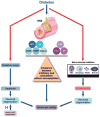Diabetes and the enteric nervous system
- PMID: 17971027
- PMCID: PMC3711013
- DOI: 10.1111/j.1365-2982.2007.01023.x
Diabetes and the enteric nervous system
Abstract
Diabetes is associated with several changes in gastrointestinal (GI) motility and associated symptoms such as nausea, bloating, abdominal pain, diarrhoea and constipation. The pathogenesis of altered GI functions in diabetes is multifactorial and the role of the enteric nervous system (ENS) in this respect has gained significant importance. In this review, we summarize the research carried out on diabetes-related changes in the ENS. Changes in the inhibitory and excitatory enteric neurons are described highlighting the role of loss of inhibitory neurons in early diabetic enteric neuropathy. The functional consequences of these neuronal changes result in altered gastric emptying, diarrhoea or constipation. Diabetes can also affect GI motility through changes in intestinal smooth muscle or alterations in extrinsic neuronal control. Hyperglycaemia and oxidative stress play an important role in the pathophysiology of these ENS changes. Antioxidants to prevent or treat diabetic GI motility problems have therapeutic potential. Recent research on the nerve-immune interactions demonstrates inflammation-associated neurodegeneration which can lead to motility related problems in diabetes.
Figures

References
-
- Bytzer P, Talley NJ, Leemon M, et al. Prevalence of gastrointestinal symptoms associated with diabetes mellitus: a population-based survey of 15,000 adults. Arch Intern Med. 2001;161:1989–96. - PubMed
-
- Furness JB, Kunze WA, Clerc N. Nutrient tasting and signaling mechanisms in the gut II. The intestine as a sensory organ: neural, endocrine, and immune responses. Am J Physiol. 1999;277:G922–8. - PubMed
-
- Monckton G, Pehowich E. Autonomic neuropathy in the streptozotocin diabetic rat. Can J Neurol Sci. 1980;7:135–42. - PubMed
-
- Fregonesi CE, de Miranda-Neto MH, Molinari SL, et al. Quantitative study of the myenteric plexus of the stomach of rats with streptozotocin-induced diabetes. Arq Neuropsiquiatr. 2001;59:50–3. - PubMed
-
- Zanoni JN, de Miranda Neto MH, Bazotte RB, et al. Morphological and quantitative analysis of the neurons of the myenteric plexus of the cecum of streptozotocin-induced diabetic rats. Arq Neuropsiquiatr. 1997;55:696–702. - PubMed
Publication types
MeSH terms
Grants and funding
LinkOut - more resources
Full Text Sources
Other Literature Sources
Medical

